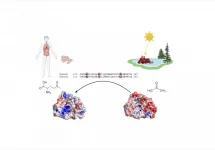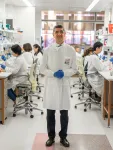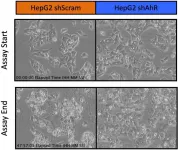Low-temperature crystallization of phase-pure α-formamidinium lead iodide enabled by study
2021-05-11
(Press-News.org) Though different fabrication approaches exist, two-step deposition is one of the main experimental techniques now used to make efficient, stable PSCs, especially on the industrial scale. The process involves first depositing lead iodide (PbI2) and then adding halide salts of monovalent cations such as methylammonium iodide (MAI) and formamidinium iodide (FAI) to convert it to perovskite.
While this two-step deposition is better than other options, it is difficult to maintain reproducible high performance and long-term stability when scaling up, mostly because of a lack of control over the fabrication process. Gaining an understanding of the mechanism behind halide perovskite crystallization at the atomic level is therefore essential.
In the paper A combined molecular dynamics and experimental study of two-step process enabling low-temperature formation of phase-pure α-FAPbI3 the authors chose to study, to this end, the two-step fabrication of methylammonium lead iodide (MAPbI3) and formamidinium lead iodide (FAPbI3).
While the former is a well-studied system, the latter was chosen because of attractive features including a ?1.45-eV bandgap, high-charge carrier mobility, and superior thermal stability that appear in its α-FAPbI3 polymorph. The problem with this perovskite however is that the α phase is metastable and the thermodynamic phase transition requires high temperatures of around 150 degrees Celsius. The combined experimental and theoretical study, published in the 23 April issue of Science Advances, uncovered the microscopic details of the crystallization process, leading the way to the discovery of a low-temperature pathway to the fabrication of the material.
While previous experimental research on MAPbI3 revealed that the two-step process occurs via intercalation of the MA+ cations in PbI2 layers followed by a transformation to the perovskite structure via intermediate phases, the experiments couldn't resolve the nature of these intermediate phases or clarify the underlying atomistic mechanism. Using a molecular dynamics (MD) investigation based on an enhanced sampling technique called metadynamics (WTMetaD), the team found that that transformation takes place through a sequence of intermediates. The theoretical results were in line with experiments, encouraging the researchers to investigate whether a similar process was also behind the transformation of α-FAPbI3. Starting from simulations, they discovered that a two-step process is indeed possible at lower temperatures in this material. A series of in situ x-ray and thin-film experiments then confirmed this result and enabled the low-temperature formation of phase-pure α -FAPbI3 thin films.
INFORMATION:
[Attachments] See images for this press release:

ELSE PRESS RELEASES FROM THIS DATE:
2021-05-11
EAST LANSING, Mich. - An acute loss of smell is one of the most common symptoms of COVID-19, but for two decades it has been linked to other maladies among them Parkinson's disease and dementia. Now, a poor sense of smell may signify a higher risk of pneumonia in older adults, says a team of Michigan State University researchers.
"About a quarter of adults 65 years or older have a poor sense of smell," said Honglei Chen, a professor in the Department of Epidemiology and Biostatistics within MSU's College of Human Medicine. "Unlike vision or hearing impairment, this sensory deficit has been largely neglected; more than two-thirds of people with a poor sense of smell do not know they have it."
In a first-of-its-kind study, Chen and his team found a possible link ...
2021-05-11
Simon Fraser University researchers have designed a remarkably fast engine that taps into a new kind of fuel -- information.
The development of this engine, which converts the random jiggling of a microscopic particle into stored energy, is outlined in research published this week in the END ...
2021-05-11
Scientists now better understand early bacterial evolution, thanks to new research featuring University of Queensland researchers.
Bacteria comprise a very diverse domain of single-celled organisms that are thought to have evolved from a common ancestor that lived more than three billion years ago.
Professor Phil Hugenholtz, from the Australian Centre for Ecogenomics in UQ's School of Chemistry and Molecular Biosciences, said the root of the bacterial tree, which would reveal the nature of the last common ancestor, is not agreed upon.
"There's great debate about the root of this bacterial tree of life and indeed whether bacterial evolution should even be described as a tree has been contested," Professor ...
2021-05-11
Just a few changes to an enzyme's amino acids can be enough to dramatically change its function, enabling microbes to inhabit wildly different environments.
University of Queensland microbiologist Associate Professor Ulrike Kappler, led by an international team of researchers, made this discovery when investigating how Haemophilus influenzae bacteria colonise the human respiratory system.
"This disease-causing bacterium is supremely adapted to living in humans, so much so that they cannot survive anywhere else," Dr Kappler said.
"It turns out that one enzyme, MtsZ, is the key player in this adaptation.
"But, surprisingly, ...
2021-05-11
Researchers have been able to reduce scarring by blocking part of the healing process in research that could make a significant difference for burns and other trauma patients.
University of Queensland Professor Kiarash Khosrotehrani said scars had been reduced by targeting the gene that instructs stem cells to form them in an animal study.
"The body's natural response to trauma is to make plenty of blood vessels to take oxygen and nutrients to the wound to repair it," Professor Khosrotehrani said.
"Once the wound has closed, many of these blood vessels become fibroblast cells which produce the collagens forming the hard materials found in scar tissue.
"We found that vascular stem cells determined whether a blood vessel was retained or gave rise to scar material ...
2021-05-11
CORVALLIS, Ore. - A team of Oregon State University scientists has discovered a new class of anti-cancer compounds that effectively kill liver and breast cancer cells.
The findings, recently published in the journal Apoptosis, describe the discovery and characterization of compounds, designated as Select Modulators of AhR-regulated Transcription (SMAhRTs).
Edmond Francis O'Donnell III and a team of OSU researchers conducted the research in the laboratory of Siva Kolluri, a professor of cancer research at Oregon State. They also identified the aryl hydrocarbon receptor (AhR) as a new molecular target ...
2021-05-11
Researchers looking to help people suffering from addiction, depression, and pain are studying how certain brain neurons operate to see if they can be controlled.
In a paper published May 11 in Neuron, researchers at the University of Washington School of Medicine and Washington University in St. Louis, along with several other universities, successfully used a protein called parapinopsin to turn off brain circuits. This protein is found in lamprey - an ancient lineage of jawless fish similar to eel. Reserachers said the ability to inhibit neurons could eventually lead to turning ...
2021-05-11
BUFFALO, N.Y. - Americans are in chronic pain, and a comprehensive new study exploring trends in this major public health concern reveals that what has been a long-standing and under-acknowledged problem is getting substantially worse.
The findings, published in the latest issue of the journal Demography, suggest blanket increases across multiple measures, with pain rising in every adult age group, in every demographic group, and at every site of pain for which data exists. People today are experiencing more pain than individuals of the same age in earlier decades. In fact, each subsequent birth group is in greater pain than the one that came before it.
"We ...
2021-05-11
BOSTON - It's a real-life plot worthy of a classic spy novel: Researchers at Massachusetts General Hospital (MGH), the Dana-Farber Cancer Institute and other Boston-area research centers are turning the tables on glioblastomas, the most devastating and aggressive form of brain cancer, by transforming a type of cell that normally protects tumors and inhibits effective drug therapy into a stone-cold glioblastoma killer.
Glioblastoma, a type of brain tumor, is rapidly fatal: Most patients die within two years of diagnosis despite aggressive therapies such as brain surgery, whole-brain radiation and chemotherapy.
Despite hopes that a class of drugs known as immune checkpoint blockers (ICBs) - drugs that have revolutionized the treatment ...
2021-05-11
DURHAM, N.C. -- With mosquito season upon us, people are stocking up on repellents to prevent itchy bites. Bug repellents are important because they don't just protect against the buzzing, blood-sucking little pests -- they also safeguard against the diseases they carry, which kill some 700,000 people worldwide each year.
Surprisingly, despite widespread use, no one understood exactly how most mosquito repellents keep the insects away. Now researchers are starting to uncover the first pieces of the puzzle.
A new study has identified a scent receptor in mosquitoes that helps them sniff out and avoid trace amounts of pyrethrum, a plant extract used for centuries to repel biting insects.
One ...
LAST 30 PRESS RELEASES:
[Press-News.org] Low-temperature crystallization of phase-pure α-formamidinium lead iodide enabled by study




